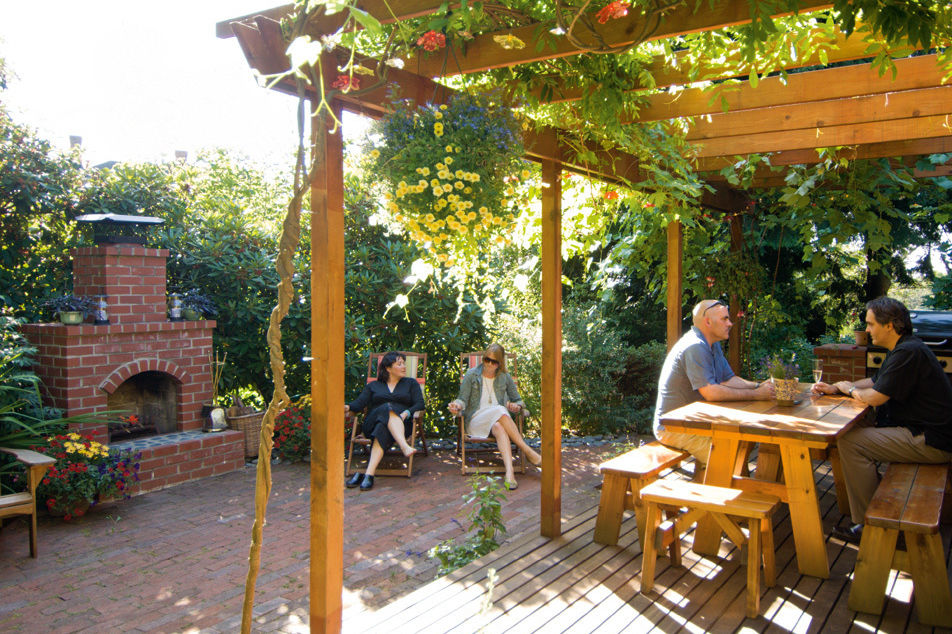Bathroom in a Box
SHARING A SINGLE BATHROOM among many people is a common hardship in older homes. The list of inconveniences runs long: smears of toothpaste from eager toddlers, meager medicine-cabinet space, sparse hot water for those last in the shower. Add houseguests to the mix and it’s a sure recipe for family drama. “When we bought our house, it was just the two of us, and adding a bath wasn’t even on our radar,” says Laura Steur-Alvarez of the Northwest Portland home she and her husband, Jason Alvarez, purchased in 2000. But the arrival of their son Coleman, now 8, and an influx of visitors prompted the couple to yearn for a master suite. “We often joked about putting a shower sign-up sheet on the bathroom door,” Steur-Alvarez recalls. “We needed more than one bathroom.”
When they bought it, their century-old Craftsman was in a state of disrepair, with peeling wallpaper and old wiring. The couple carefully undertook intensive renovations, focusing on preserving the home’s original aesthetics. But their tastes tend toward modern minimalist, and they wanted their new master suite to showcase their personal style. “We like the old with the new, the contrast between the two,” Alvarez says.
So they hired Portland-based architect Paul McKean to tackle the project. An understated architect who favors clean lines, straightforward solutions, and a commitment to one material rather than a lot of architectural clutter, McKean is known for his attention to his clients’ needs. In this case, the homeowners wanted a modern bath but also wanted to be respectful of the home’s original architectural vintage. McKean’s solution was an ingenious modernist fantasy. He imagined a cube—a six-foot-by-eight-foot walnut box—suspended in the house without touching the walls. To make this vision a reality, McKean appropriated a room next to the master bedroom—and with the demolition of one dividing wall, a master suite was born.
McKean’s cube is a dramatic centerpiece for the home, and it took a lot of work to get it right. Unlike ornate cabinets, where crooked edges or gaping seams can be covered with a piece of trim, the straight lines of the cube—made of stained walnut veneer on top of a plywood base—had to be perfect. The general contractor, Jason Peck of Arts and Craftsmen, custom-made it and the other cabinetry in the space. “He referred to the cube as his ‘mistress,’” McKean chuckles, “because he was spending so much time with it.”
Anchored within the cube are a glass-walled shower on one side and a closet for Steur-Alvarez on the other. The rest of the bathroom sits elegantly around the walnut walls. Everything is white—the fixtures, the ceramic floor and wall tiles, even the paint—and the dark walnut tones pop dramatically against this clean palette, which interior designer Jennifer Fowler (Jennifer Fowler Interiors, 7135 SE Thorburn St, 503-804-5270) helped to create. A cantilevered sink holding two basins extends effortlessly from a wall. The toilet is tucked into what used to be a closet, separated from the room by a sheer white curtain on a recessed aluminum track. Nothing is crowded, and the space feels expansive. “We wanted to make sure there was enough space around everything to keep it feeling open,” Alvarez says.
Despite the space’s modern aesthetic, a strong sense of traditional design remains throughout. The moldings match those in the rest of the house, and the pocket doors on either side of the cube are styled conservatively. Even the curved sconces over the sink are a nod to the past. The original windows and radiator were preserved, and the fir floor in the closet was rescued from the old bedroom.
The result is a happy marriage of old and new—and some breathing room for the family and their guests. “The bathroom we came from was so modest,” Steur-Alvarez says. “When I look at our master suite, I think, ‘What more could a girl want?’”





